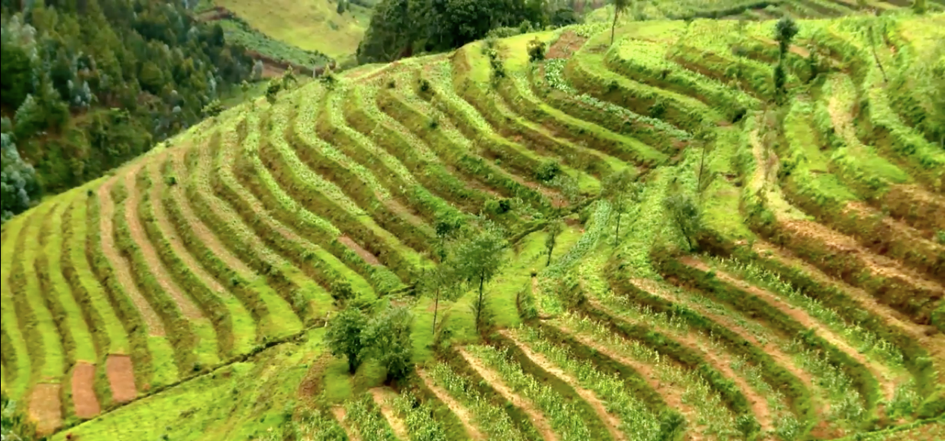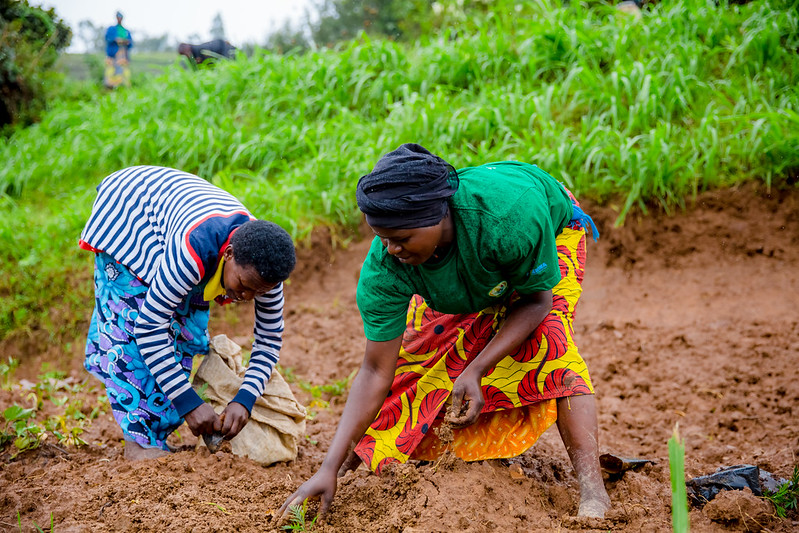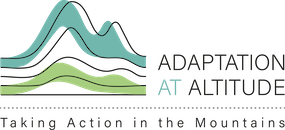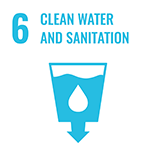The Green Gicumbi project in Rwanda

Summary
The Strengthening Climate Resilience of Rural Communities project, commonly known as the Green Gicumbi Project, was launched in 2019 in northern Rwanda as a six-year project to promote climate change resilience in the area. Following an integrated landscape management model, it will help restore and enhance degraded watershed ecosystems and promote sustainable management of forest resources.
Rwanda is often called the “land of the thousand hills” due to its topography. This hilly topography is highly vulnerable to hazards like landslides, floods, and droughts. Communities across the country have witnessed a series of climate-related incidents that have caused devastating impacts, such as crop destruction due to floods and landslides. Gicumbi district is found in the Northern Province of Rwanda, and in 2018 the district was ranked the highest in exposure to climate hazards and second highest in sensitivity to climate-related impacts.
As part of the Green Gicumbi project, terraces have been introduced on these steep cultivated hills to promote climate-resilient farming practices. The terraces, which consist of stepped cuts in the hills, are constructed to control flooding, reduce soil erosion and improve productivity, and seeds are then planted on the horizontal part of the terraces, where they can grow. Before the terraces were built through the initiative, the manure that farmers applied to their plots was washed away by erosion. Nevertheless, the project generally consists of 133 activities under 4 main components that are:
- Watershed protection and climate-resilient agriculture
- Sustainable forest management and sustainable energy
- Climate-resilient settlements
- Knowledge transfer and mainstreaming
Overview
- Location:
- Implementation sites:
-
- Single country
- Single location
- Mountain region:
-
Gicumbi
- Site locations:
-
Kaniga, Rubaya, Cyumba, Rushaki, Shangasha, and Mukarange sectors in the Gicumbi District.
- Solution scale:
- Ecosystem type(s):
- Solution type(s):
- Climate impact(s) addressed:
- Climate impact time-scale(s):
- Main benefit associated with the solution:
- Co-benefit(s) associated with the solution implementation:
-
- Climate risk reduction (e.g. reduced risk from floods)
- Economic benefits (e.g. job creation, tourism)
- Environmental benefits (e.g. biodiversity preservation, water security, food security)
- Social benefits (e.g. poverty reduction, inclusiveness and equity, health and well-being)
- Technical benefits (e.g. innovative use of geographic information systems)
- Implementation timeline:
-
- 2019 - 2022
Solution details
Main beneficiaries & outcomes
The project targeted nine sectors in the Gicumbi district, which includes 252 villages and is home to just under 250,000 residents. Since its launch in October 2019, the project has achieved several results through its four different components, including the establishment of 400 ha of root terraces and 410 ha of progressive terraces, 1,500 local authorities and community representatives trained on project objectives and climate change, 4,700 check dams under construction, 747 ha of degraded forests rehabilitated, 2,000,000 fruit tree seedlings produced and planted, 3 automated weather stations established, and 21,000 green jobs created.
In the case of terraces, these are supporting tree planting and agriculture production, which were previously heavily affected by heavy soil erosion. The terracing has improved agricultural productivity, increased food security, and improved the livelihoods of the people in the communities, the majority of them farmers.
Planning and implementation
The project, which is one of Rwanda’s largest green growth investments, is currently being implemented by the Rwanda National Climate and Environment Fund (FONERWA) with funding from the Green Climate Fund (GCF). The Ministry of Environment is the accrediting entity. The four components that constitute the initiative have been tailored to address the specific issues related to watershed protection through land cultivation practices, including land and soil protection measures.
Finance
The project was supported by a USD 32.8 million grant from Green Climate Fund (GCF). In addition, other contributions include USD 147,000 by the Rwanda Green Fund, USD107,000 by the Gicumbi District, and USD 106,000 by the Wood Foundation.
Innovation
The solution is employing cost-effective and innovative strategies along the value chain to foster climate-resilient agriculture. From modern inputs and technology that help maximize the productivity of local communities to the use of local social groups for the successful implementation of some products. Some important interventions in this regard are the piloting of household biogas units, the construction of a wood drying shed, the construction of infiltration ditches, and the installation of automated water stations. The use of root terraces is suitable for Gicumbi’s topography and effective in controlling soil erosion.
Performance evaluation
Stakeholders constantly report on the performance of the various activities carried out through an official website specially designed to share project information. In addition, evaluations and performance reports are also conducted as part of the project’s obligations to the GCF to report on its progress. Some field visits are conducted by relevant actors such as the Rwanda Agriculture Board (RAB), district technicians, and the Technical Coordination Committee.
Long term project sustainability and maintenance
Various strategies and maintenance plans are being put in place for each of the four project components to ensure the long-term sustainability of the outputs. Examples include the establishment of watershed committees and their training in the technical skills needed to manage check dams, capacity building efforts for forest management among various stakeholders including private forest owners, volunteers, and technicians, and the signing of Memorandums of Understanding (MoU) with youth cooperatives for the subsequent continuity of the nurseries for both business and forest rehabilitation. All this is supported by the inclusion of local communities in the different activities implemented, which increases their awareness and improves the possibility of solution ownership.
Capacities for design and implementation
Knowledge
Important in providing baseline information regarding the status of Gicumbi district in relation to climate vulnerability was the Rwanda Climate Change Vulnerability Assessment and Index Final Report national survey (2018), which served to identify the district as having the highest exposure to climate hazards and being the second most sensitive to climate-related impacts within the country’s Northern Province.
The project executing entities are providing technical and experience support to the communities in accordance with the different outputs that are being implemented. In addition, an environmental and social specialist is planned to be engaged to continue providing support to mitigate and reduce potential environmental and social risks and/or conflicts in the intervention areas.
Technology
Certain technology capacities from implementing partners have been important for the achievement of various outcomes such as the establishment of 3 automated weather stations under component 1 and the installation of domestic biogas units constructed as a pilot solution under component 2.
Political / Legal
This project was triggered by the initiative of the Government of Rwanda, which, through the Ministry of Environment, applied for funding from the Green Climate Fund. The main implementing entity at the local government level is the Gicumbi District Authority, which oversees and coordinates activities in Gicumbi, while many of the project interventions are supported by relevant government sector agencies.
In terms of some of the national policies and strategies most relevant to this adaptation solution, the Green Growth and Climate Resilience Strategy (GGCRS) provides the country’s pathway for becoming a climate-resilient and low carbon economy by 2050, and Rwanda’s National Adaptation Plan of Action (NAPA) outlines the country’s strategy to reduce its vulnerability to climate change.
Institutional
One of the main coordination strategies established under the project and which is proving instrumental in its implementation is the establishment and formation of Community Coordination Committees, which are composed of representatives of local administrative levels and beneficiary groups. There are also Technical Coordination Committees, represented by different institutions to ensure that project interventions are integrated into their respective institutions’ annual plans. The project is managed by a Project Steering Committee.
Socio-cultural
Local communities are actively involved in the different components of the project and their respective interventions as a means to ensure its long-term sustainability and to raise awareness among the general population about the impacts of climate change affecting the region, as well as to promote the adoption of more sustainable and climate-resilient practices. Gender-balanced participation is sought, as well as the integration of young people.

Outlook & Scalability
Barriers and adverse effects
Although the project is still ongoing, the latest published annual report (2020) notes that the COVID-19 pandemic has posed a number of challenges to project implementation due to travel and gathering restrictions. Among these impacts are the postponement of field missions to collect or validate project information with stakeholders, delays in pilot initiatives, and limited opportunity to conduct community awareness sessions. However, the project team devised some creative strategies to reduce these constraints, such as the use of community radios and megaphones to deliver key messages to the local population.
Transformation and future outlook
The Gicumbi pilot project supports fundamental change in the targeted areas by strengthening the adaptive capacities of the population and institutions and by reducing their exposure to climate-related risks. By promoting adequate strategies and management plans in accordance with the actual and expected climate impacts, the project implementers are helping communities move away from undesired pathways. Moreover, the solution is also combining mitigation actions together with adaptation for fostering sustainability.
Potential for upscaling and replication
According to the implementing institutions, as a pilot initiative that aims to test strategies for increasing climate resilience, enhancing the adoption of low-carbon technologies, and permit the creation of green jobs, the project has great potential for scaling up and replicating the results of interventions in other parts of the country in a cost-effective manner. Therefore, once the project is completed, efforts will be made to raise awareness, promote, share lessons learned, and advocate for this purpose.









Comments
There is no content